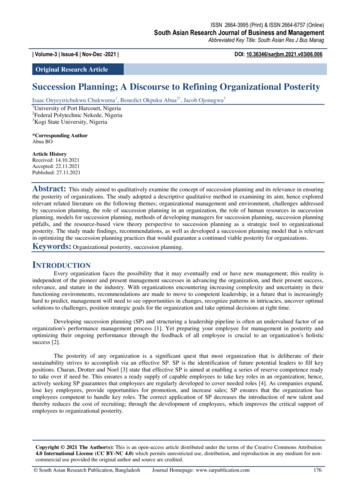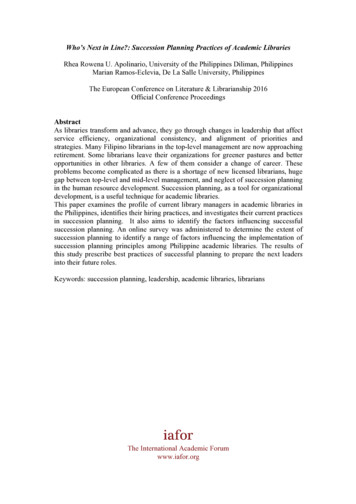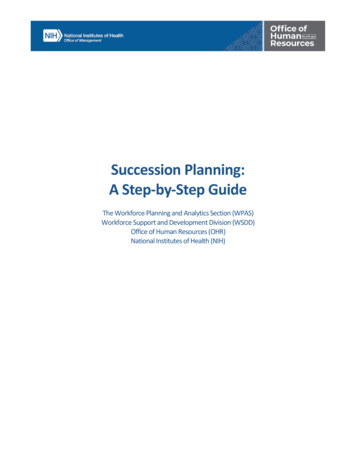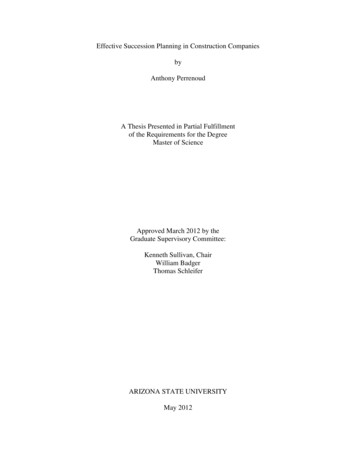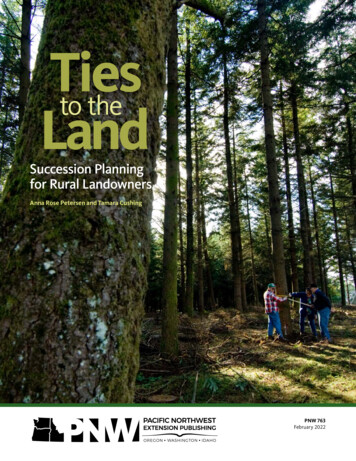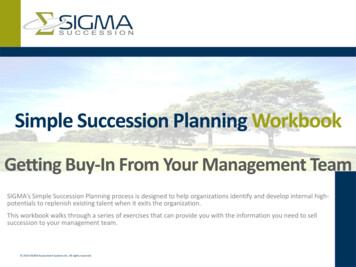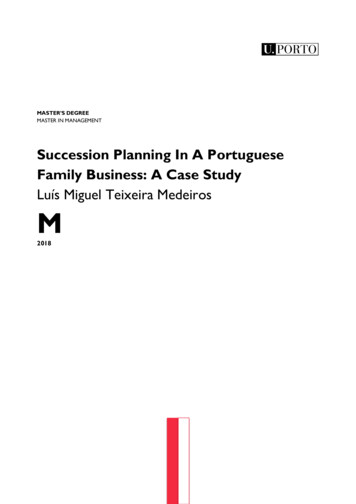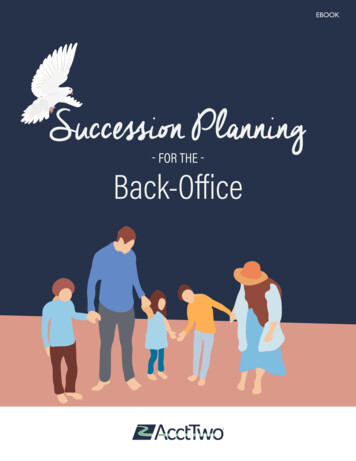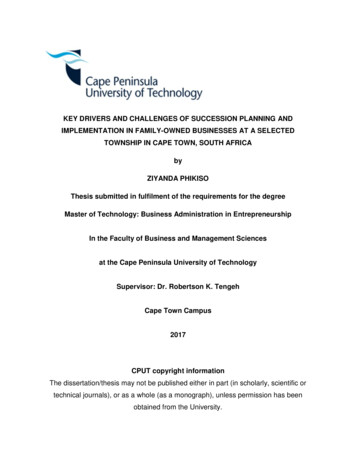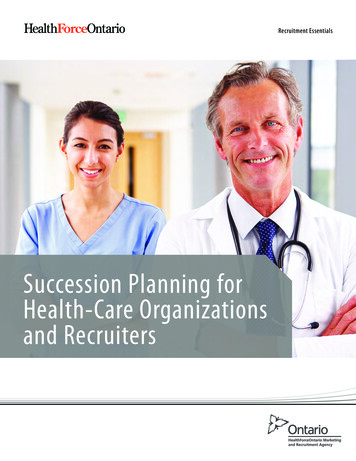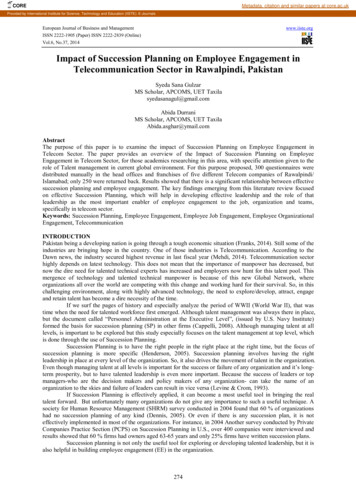
Transcription
COREMetadata, citation and similar papers at core.ac.ukProvided by International Institute for Science, Technology and Education (IISTE): E-JournalsEuropean Journal of Business and ManagementISSN 2222-1905 (Paper) ISSN 2222-2839 (Online)Vol.6, No.37, 2014www.iiste.orgImpact of Succession Planning on Employee Engagement inTelecommunication Sector in Rawalpindi, PakistanSyeda Sana GulzarMS Scholar, APCOMS, UET Taxilasyedasanagul@gmail.comAbida DurraniMS Scholar, APCOMS, UET TaxilaAbida.asghar@ymail.comAbstractThe purpose of this paper is to examine the impact of Succession Planning on Employee Engagement inTelecom Sector. The paper provides an overview of the Impact of Succession Planning on EmployeeEngagement in Telecom Sector, for those academics researching in this area, with specific attention given to therole of Talent management in current global environment. For this purpose proposed, 300 questionnaires weredistributed manually in the head offices and franchises of five different Telecom companies of Rawalpindi/Islamabad; only 250 were returned back. Results showed that there is a significant relationship between effectivesuccession planning and employee engagement. The key findings emerging from this literature review focusedon effective Succession Planning, which will help in developing effective leadership and the role of thatleadership as the most important enabler of employee engagement to the job, organization and teams,specifically in telecom sector.Keywords: Succession Planning, Employee Engagement, Employee Job Engagement, Employee OrganizationalEngagement, TelecommunicationINTRODUCTIONPakistan being a developing nation is going through a tough economic situation (Franks, 2014). Still some of theindustries are bringing hope in the country. One of those industries is Telecommunication. According to theDawn news, the industry secured highest revenue in last fiscal year (Mehdi, 2014). Telecommunication sectorhighly depends on latest technology. This does not mean that the importance of manpower has decreased, butnow the dire need for talented technical experts has increased and employers now hunt for this talent pool. Thismergence of technology and talented technical manpower is because of this new Global Network, whereorganizations all over the world are competing with this change and working hard for their survival. So, in thischallenging environment, along with highly advanced technology, the need to explore/develop, attract, engageand retain talent has become a dire necessity of the time.If we surf the pages of history and especially analyze the period of WWII (World War II), that wastime when the need for talented workforce first emerged. Although talent management was always there in place,but the document called “Personnel Administration at the Executive Level”, (issued by U.S. Navy Institute)formed the basis for succession planning (SP) in other firms (Cappelli, 2008). Although managing talent at alllevels, is important to be explored but this study especially focuses on the talent management at top level, whichis done through the use of Succession Planning.Succession Planning is to have the right people in the right place at the right time, but the focus ofsuccession planning is more specific (Henderson, 2005). Succession planning involves having the rightleadership in place at every level of the organization. So, it also drives the movement of talent in the organization.Even though managing talent at all levels is important for the success or failure of any organization and it’s longterm prosperity, but to have talented leadership is even more important. Because the success of leaders or topmanagers-who are the decision makers and policy makers of any organization- can take the name of anorganization to the skies and failure of leaders can result in vice versa (Levine & Crom, 1993).If Succession Planning is effectively applied, it can become a most useful tool in bringing the realtalent forward. But unfortunately many organizations do not give any importance to such a useful technique. Asociety for Human Resource Management (SHRM) survey conducted in 2004 found that 60 % of organizationshad no succession planning of any kind (Dennis, 2005). Or even if there is any succession plan, it is noteffectively implemented in most of the organizations. For instance, in 2004 Another survey conducted by PrivateCompanies Practice Section (PCPS) on Succession Planning in U.S., over 400 companies were interviewed andresults showed that 60 % firms had owners aged 63-65 years and only 25% firms have written succession plans.Succession planning is not only the useful tool for exploring or developing talented leadership, but it isalso helpful in building employee engagement (EE) in the organization.274
European Journal of Business and ManagementISSN 2222-1905 (Paper) ISSN 2222-2839 (Online)Vol.6, No.37, 2014www.iiste.orgIt is a human factor that every person needs a tangible or intangible reward for his hard work, andpromotions are one of these rewards, which motivates him to increase his engagement in his organizational tasksor duties. Just like succession planning, employee engagement is also Plays a vital role in bringing success to theorganization. High level of employee engagement can retain the talent in the organization resulting in improvedorganizational performance and stakeholder value. Employee engagement is influenced by many factors, i.e. ifwe look at workplace culture, from organizational communication and managerial styles, to trust and respect,leadership and company reputation etc. In current dynamic culture of organizations, access to training and careeropportunities, work-life balance and empowerment to make decisions, are very important (Lockwood, 2007, p.3).Thus, to promote a culture of engagement, Succession planning helps in designing, measuring and evaluatingproactive workplace policies and practices that help attract and retain talent with skills and competenciesnecessary for growth and sustainability of the organization.PROBLEM STATEMENTKeeping in mind the magnitude of succession planning and its impact on employee engagement, in this paper thediscussion centers at the impact of succession planning on employee engagement in Telecommunication sectorin Rawalpindi, Pakistan. This study will serve as a building block for future researches.Research Question:Does Succession Planning has a positive impact of effective succession planning on Employee engagement intelecom sector?Does Succession Planning has a positive impact of effective succession planning on Employee Job engagementin telecom sector?Does Succession Planning has a positive impact of effective succession planning on Employee Organizationalengagement in telecom sector?Research Objectives:To explore the impact of effective succession planning on Employee engagement in telecom sectorTo explore the impact of effective succession planning on Employee job engagement telecom sectorTo explore the impact of effective succession planning on Employee organizational engagement telecom sectorLITERATURE REVIEWDue to the transformation of the world into a global village, a unique change has been witnessed in the marketplace, where many companies are competing for talent. As organizations enter into a non-peripheral environment,the ability to explore, attract, engage and retain talent will gradually become more important (Lockwood, 2007).David Watkins (1998) first coined the term, talent Management. Since then, the societies and companies realizedthat the talent of the employees plays the key role in the success of a business (Teo, 2010).Effective talent management policies and practices that demonstrate commitment to human capitalresult in more engaged employees and lower turnover (Lockwood, 2006). In addition, the foundation for anengaged workforce is established by the quality, depth and authenticity of communication by senior managementto employees, as well as the quality of supervision. Here, the role of the manager is the most important enabler ofemployee engagement to the job, organization and teams in an organization (CLC, 2004).Succession PlanningInvestment in human capital requires careful planning. Under the talent management umbrella, successionplanning and leadership development are important organizational business strategies to develop and retain talent.According to Human Capital Index Report (2005), succession planning is also one of the key strategies to reduceturnover costs (Wyatt, 2005) and the likelihood of employee engagement will be increased.Engagement is important whatever the potential of the employee, but according to Dr. Woodruffe, it isespecially crucial for truly talented people who are likely to have leadership potential. Engaging talented Peopleneeds to be a top organizational priority because they are by definition especially precious possessions.Globally, Succession planning is the hottest topic today. Rothwell (2001, p. 29) defines SuccessionPlanning as a systematic process which is carried out especially for the continuity in key leadership positions, inorder to retain and develop future intellectual Capital of the organization. The process of Succession Planningshould be strategically aligned with organization’s vision and it should be helpful in providing a crucial startingpoint for leadership and employee development programs in an organization.Wolfe (1996) and Rothwell (2001) suggested that there is a dire need to have the routine succession ofpositions within an organization, in order to stop the unnecessary job fill. These techniques are helpful indetermining any succession plan as being successful or vice versa.275
European Journal of Business and ManagementISSN 2222-1905 (Paper) ISSN 2222-2839 (Online)Vol.6, No.37, 2014www.iiste.orgEmpirical evidence found in this regard, suggests that the basic tenants of a succession planningprocess would drive towards: Establishing development and training plans, communicating upward and laterallyconcerning the management organization, creating a more comprehensive human resources planning system, andestablishing career paths and individual job moves (Rothwell, 2001, p.9).Employee Engagement:Employee engagement is now considered as the most important factor in the success of any organization.Globally, organizations are trying hard to engage their employees in their work, by offering them different typesof tangible and intangible rewards. Different researches suggest that employee engagement plays the importantrole in retaining talent in any organization.According to Saks, Employee Engagement within an organization is tow folds, Job Engagement andimmediate Work Engagement (2006). According to the scholars, employee engagement is incomplete, if any ofthe before mentioned dimensions, is missing in his job. Another scholar suggested four dimensions of employeeengagement, but his focus was Gallup’s 12 employee engagement factors. These dimensions are: growth of anemployee, belongingness, what he is giving to the organization and what he is getting in return (Fleming, 2007).Saks discussed in his research the antecedents and consequences of employee engagement, proposed in Kahn(1990) and Maslach et al. (2001) model (2006, p.602). According to him, the antecedents of employeeengagement include; 1) Job Characteristics, 2) perceived organizational support, 3) perceived supervisor’ssupport, 4) Rewards and recognition, (succession planning is also one of these rewards) 5) procedural justiceand 6) Distributive Justice. The consequences discussed in his research include; 1) job satisfaction, 2)organizational commitment, 3) Intention to quit, 4) organizational citizenship and 5) Behavior.SP and EE in Public, Private and Non-for-Profit Organizations:Literature suggest that succession planning is mostly studied in the context private firms, out of 130 studies from1980-1993, there are only five researches which studied succession planning in public sector (Wilkerson, 2007,p.3). Schall in her study on succession planning revealed that the serious study of SP in Public sector started in1992 by the National Academy of Public Administration which was the result of increased turnover in this sector(1997, p.6). She also discovered that there is a lack of focus on this issue in public sector. Kesner and Seborafound only three studies related to succession planning transition in Non-for-Profit sector and according to themall of these studies focused on Universities only (1994).Although EE is a hot debate everywhere, but we do not find much literature on sectoral comparison EE.However, literature on employee engagement suggests that in corporate sector employees are expected to worklonger hours in a day, they have to take more responsibility on them, they have to be more flexible and they haveto build more tolerance with this rapid change and ambiguity (Herriot and Pemberton, 1995), so instead ofincreased employee engagement, people in this sector are more psychologically ill (Barling, Kelloway, & Frone,2005). Literature related to EE in Public Sector suggests that in public sector employees are more engaged intheir work as compared to private sector, because of the intrinsic reward they gain from public service. However,surveys usually oppose this idea (Williams, 2003). However, if we talk about Non-for-profit sector, according toGuevara & Ord, people are now shifting from materialistic to post materialistic era and individualistic culturalvalues are being rejected by the society, now people are seeking for greater meaning and a purpose of their lives(1996, p.711). It derives more employee engagement in people who are working for the welfare of the societyalong with greater chances of making money.Hypothesis:Therefore the proposed hypothesis of the study are:H1: Effective Succession Planning positively effects Employee engagement in telecom SectorH2: Effective Sp increases the likelihood of Employee Job Engagement in Telecom SectorH3: Effective Sp increases the likelihood of Employee Organizational Engagement in Telecom Sector.276
European Journal of Business and ManagementISSN 2222-1905 (Paper) ISSN 2222-2839 (Online)Vol.6, No.37, 2014www.iiste.org277
European Journal of Business and ManagementISSN 2222-1905 (Paper) ISSN 2222-2839 (Online)Vol.6, No.37, 2014www.iiste.org200 (80%) belonged to private sector and only 50 (20%) were from public sector. 190 (76%) were AssistantManagers and other 60 (24%) were Managers.The mean of the gender 1.32, ages 3.56, marital status 1.86, education 2.46, no. of yrs workingwith current organization 3.32, sector 1.80, and designation 1.76. The Standard Deviation of the gender 1,ages 4, marital status 2, education 2, no. of yrs working with current organization 4, sector 2, anddesignation 2.4.3 RELIABILITY ANALYSIS:In order to obtain true results, two combined variables were formed by using compute tab in SPSS, namely SPand EE. These variables included all the relevant items or variables in them excluding the demographics. Thenreliability test was applied separately on each variable. The reliability results for SP 0.669 and EE 0.861.4.4 SIMPLE REGRESSION:The linear regression results for H1 are as follows: The results were statistically significant F (1, 43) 24.070,p 0.001. The identified equation to understand this relationship was EE .35 1.72 (SP) The adjusted R squarevalue was .344. This indicates that 34 % of the variance in EE was explained by SP. According to Cohen (1988)this is a large effect. The value of R square 0.359 0.25, ANOVA 0.000 0.05, and t sig value was 0.000 0.05.The simple regression results for H2 are as follows: The model summary table shows that the multiplecorrelation coefficient (R), using both predictors simultaneously, is .528 and the Adjusted r² is 27 %, meaningthat 27 % of the variance in JE can be predicted from SP. the coefficient table is showing a Sp as significant,therefore it will always add more to the prediction of JE. The ANOVA table shows that F(1, 43) 16.62, and p 0.001, and it is statistically significant. The t value and the sig opposite independent variable indicates that bothvariables are adding anything to the prediction.The simple regression results for H3 are as follows: The model summary table shows that the multiplecorrelation coefficients (R), using both predictors simultaneously, is .372 and the Adjusted r² is 36 %, meaningthat 36 % of the variance in OE can be predicted from the combination of SP and P. The coefficient table isshowing a SP and P, both are significant, therefore they will always add more to the prediction of OE. TheANOVA table shows that F (1, 45) 27.075, and p 0.001, and it is statistically significant. The t value and thesig opposite each independent variable indicates that both variables are adding anything to the prediction.Chapter 5: Discussion:The study was aimed at checking the impact of succession planning on employee engagement intelecom sector. For this purpose, the total sample size was 250, and all the respondents belonged to telecomsector. The detailed information about the descriptive statistics is being given in results sections.The reliability test scores for SP showed 0.669 values, although the reliability of SP was not high but itis acceptable according to some researchers (Garson G., D., 2011). The reliability test scores for EE showed0.861, which is an ideal value of any scale according to some researchers (Yaffee R., A, 1999, Garson G., D.,2011).Simple regression was conducted to investigate how well Succession Planning predicts employeeengagement. The results were statistically significant F (1, 43) 24.070, p 0.001. The identified equation tounderstand this relationship was EE .35 1.72 (SP) The adjusted R square value was .344. This indicates that34 % of the variance in EE was explained by SP. According to Cohen (1988) this is a large effect. The value ofR square 0.359 0.25, ANOVA 0.000 0.05, and t sig value was 0.000 0.05. From all the above mentionedresults of simple regression, I spew that my H1 is accepted, which was “Effective Sp increases the likelihood ofEE in Telecom Sector. The findings are in line to the Lockwood, N, R. (2006) research, which suggested thateffective talent management policies and practices that demonstrate commitment to human capital result in moreengaged employees and lower turnover.Simple regression was conducted to investigate how well SP predicts JE. The model summary tableshows that the multiple correlation coefficient (R), using both predictors simultaneously, is .528 and theAdjusted r² is 27 %, meaning that 27 % of the variance in JE can be predicted from SP. the coefficient table isshowing a Sp as significant, therefore it will always add more to the prediction of JE. The ANOVA table showsthat F(1, 43) 16.62, and p 0.001, and it is statistically significant. The t value and the sig opposite independentvariable indicates that both variables are adding anything to the prediction. Therefore, I spew that my H3 isproved, which was “Effective Sp increases the likelihood of JE in Telecom Sector”. These findings are in line toFleming, J, H. (2007) research, who while explaining the four dimensions of EE, suggested that one of the keyenabler of EE is Personal growth of an employee, which is a result of effective SP.Simple regression was conducted to investigate how well SP predicts OE. The model summary tableshows that the multiple correlation coefficients (R), using both predictors simultaneously, is .372 and theadjusted r² is 36 %, meaning that 36 % of the variance in OE can be predicted from the combination of SP and P.278
European Journal of Business and ManagementISSN 2222-1905 (Paper) ISSN 2222-2839 (Online)Vol.6, No.37, 2014www.iiste.orgThe coefficient table is showing a SP and P, both are significant, therefore they will always add more to theprediction of OE. The ANOVA table shows that F (1, 45) 27.075, and p 0.001, and it is statistically significant.The t value and the sig opposite each independent variable indicates that both variables are adding anything tothe prediction. Therefore, I spew that my H5 is proved, which was “Effective Sp increases the likelihood of OEin Telecom Sector”. Andrea Kittredge (2010) in his research, checked the relationship between OrganisationalEngagement and overall personality hardiness (commitment, control and challenge), his findings also suggestedthat overall hardiness was significantly related to organizational engagement. This finding also be linked withMaslow (1970) hierarchy of need, where while discussing human motivation and metamotivation, he said, thereare two types of needs D-needs and B-needs, D-needs refer to primary needs i.e., food, shelter and clothing etc,whereas, B-needs are related to self-actualization and self-esteem, among the drivers of self-esteem, there werecertain drivers that were related to power, i.e., confidence, mastery, recognition, self respect, acceptance andstatus.5.1 Limitations and Future Implications:The first and foremost limitation of this study is scarcity of time. The topic of the study is too wide, incomparison to this, time availability is too narrow. The sample size was chosen with the help of non probabilitysampling technique, and it was on convenient bases, therefore, the sample size was too small and is notrepresentative of the whole population. Thirdly, this study shows the results from only one sector.None the less this is also a fact that the magnitude of succession planning and employee engagement has becometoo wide but still this area is ignored by the researchers in the past. It is only recently that the researchers havestarted giving due attention to this area. This study being a humble effort strongly recommends further researchin this area.CHAPTER 6: CONCLUSIONSuccession Planning is a tool used to identify the right person at the right time and at the right place, specificallyin the context of top management. Succession Planning is vital for any organization, because it helps in bringingthe right person forward to the key positions, where all the business related decisions are to be taken. Ifimplemented effectively, Succession Planning can bring high level of employee engagement in the organization,which is also a key business driver for any firm. The purpose of this paper was to check the impact of SuccessionPlanning on Employee Engagement in the telecom sector, Rawalpindi/ Islamabad.Literature suggests that there is positive relationship between SP and EE. This fact is also checked andproven by the results presented in this article. This paper is not the representative of the whole population,because it only deals with one sector of twin cities and sample size is also very small. Future researchers shouldfill the gaps represented in this research article.REFERENCES1. Bano, S. (2010) Schematizing Talent Management, A Core Business Issue. Far East Journal of Psychologyand Business. Vol. 2 No 1, pp 1-132. Barling, J., Kelloway, E, K., & Frone, M. (2005). Handbook of work stress. Thousand oaks: Sage, SAGEPublications, 2005 - Business & Economics, pp710 http://books.google.com/books?id YLuI7yN4g84C3. Barry, Lp. (2006), Business Succession planning: a review of the evidence. Journal of small business andenterprise development. Vol: 13, No: 3 http://emeraldinsight.com/ 1462-6004.htm4. Bhatnagar, J. (2007), Talent management strategy of employee engagement in Indian ITES employees: keyto retention. Employee relations, Vol. 29 No. 6, pp. 640-663http://emeraldinsight.com/0142-5455.htm5. Cappelli, P. (2008), Talent on Demand. Business Press Boston, Massachusetts, Vol:86, No: 3 pp.7481https://www.mercurymagazines.com/pdf/75 Talent Management The New Business Imperative.pdf6. Corporate Leadership Council (2004). Driving performance and retention through employeeengagementhttp://usc.edu7. Cartwright, S. (2006), The meaning of work: the challenges of regaining employee engagement andreducing cynicism. Human Resource Management Review. No. 16, pp 199-208 http:// socscinet.com/10534822.htm8. Engler, B. (2006), Humanism-Abraham Maslow, Personality theories. Houghton Mifflin Company, Boston,New York. ed. 7. pp. 346-348.9. Fleming, J, H. (2007). Human Sigma: Managing the Employee-Customer Encounter. Retrieved 23461/Powerful-Alternative-Cutting-Costs.aspx10. Franks, J. (2014). Pakistan in a difficult situation: IMF official. The dawn News.http://www.dawn.com/news/104106711. Fancher, L, P. (2007), The influence of organisational culture on the implementation of succession planning.Public management and policy dissertations. P28 http://digitalarchive.gsu.edu/pmap diss/28279
European Journal of Business and ManagementISSN 2222-1905 (Paper) ISSN 2222-2839 (Online)Vol.6, No.37, 2014www.iiste.org12. Farashah, A, D., Nasehifar, V. and Karahrudi, A, S. (2011), Succession planning and its effects on employeecareer attitudes: Study of Iranian governmental organizations. African Journal of Business ManagementVol.5, No. 9, pp. 3605-3613. http://www.academicjournals.org/AJBM13. Garson G., D., (2011). Reliability Analysis htm14. Grigoryev, P. (2006). Hiring by competency models. Journal for Quality and participation, Vol. 24, No. 4,pp. 16-18 http:// emeraldinsight.com/ 1474-6085.htm15. Groves, K, S.(2006), Integrating leadership development and Succession planning best practices. Journal ofManagement Development. Vol. 26 No. 3, pp. 239-260 http:// emeraldinsight.com/ 0262-1711.htm16. Guevara, K., & Ord, J. (1996), The search for the meaning in a changing work context. Futures, Vol. 28, No.8, pp 709-722 http://socscinet.com/1053-4822.htm17. Herriot, P., & Pemberton, C. (1995). New deals, the revolution in managerial careers. Chichester: JohnWiley and Sons 95-799-7.htm18. Henderson, T, L. 2005, Georgia’s Flexible Succession planning model. Pp 1-70 df19. Hogan, R. & Kaiser, R, B. (2005), What We Know About Leadership. Review of General Psychology. Vol.9, No. 2, pp. 169–180 2834.2003.00357.htm20. Huges, J, C. (2008), Talent Management: A strategy for improving employee recruitment, retention, andengagement within hospitality organisations. International Journal ofcontemporary hospitalitymanagement.http:// emeraldinsight.com/0959-6119.htm21. com/925.518.0187 P22. Kahn, W, A. (1992), Psychological conditions of personal engagement and disengagement at work.Academy of Management Journal, Vol. 33, No.4, pp. 692-724 http://www.jstor.org/pss/25628723. Kesner, I, P. and Sebora, T, C. (1994), Executive Succession: Past, Present and Future. Journal ofmanagement, Vol. 20, No. 2 http://jom.sagepub.com/content/20/2/327.htm24. Kittredge, A. (2010). Predicting Work and Organizational Engagement with Work and Personal Factors.Unpublished work.http://scholarworks.sjsu.edu/etd theses/377125. Levine, S.R. Crom, M. A. (1993). Teaming Up for Tomorrow. The Leader In You. Dale Carnegie &Association, Inc. pp. 103-105. ISBN: 0-671-79809-X26. Lockwood, NR., 2006. Leadership development: Optimizing human capital for business success. Society forHuman Resource Management.27. Lockwood, NR., 2007. Leveraging Employee Engagement for Competitive Advantage. Society for searchQuarterly.pdf28. Luthans, F. (2001) Employee Engagement and manager Self-efficacy: Implications for managerialeffectiveness and development. Journal of management Development. Vol. 21, No. 5, pp. 376-387 http://emeraldinsight.com/0262-1711.htm29. McCarthy, A, M. & Garavan, T, N. (1999), Developing self awareness in the managerial careerdevelopment process: the value of 360-degree feedback and the MBTI. Journal of European Industrialtraining, Vol. 23, ISS. 9, pp 437-445 http:// emeraldinsight.com/0309-0590.htm30. Mohapatra, M. & Sharma, B, R. (2010), Study of Employee Engagement and it’s predictors in an IndianPublic sector undertaking. Global business review, Vol. 11, No. 2, pp. 31. Mehdi, A.R. (2014). Spotlight on telecom industry. The Dawn http://www.dawn.com/news/108457832. Pugh, S, D. (2008), Employee Engagement at the organisational level of analysis. Industrial andorganisational Psychology. No.1, pp 44-47 434.2007.00006.htm33. Rothwell, W. J. (2001). Effective Succession Planning: Ensuring Leadership Continuity And BuildingTalent From Within, 2nd, New York: AMACOM.34. Saks, A, M. (2006) Antecedents and consequences of employee engagement. Journal of ManagerialPsychology. Vol. 21 No. 7, pp. 600-619 http://emeraldinsight.com/0268-3946.htm35. Santra, J, C. & Sarros, J, C. (1995), Mortality & leadership succession: a case study. Leadership andorganisational development journal, Vol, 16, ISS. 7, pp 29-32 http:// emeraldinsight.com/0143-7739.htm36. Schall, E. (1997) Public Sector succession: A strategic approach to sustaining innovation. Publicadministration review. Vol. 57, No. 1, pp 4-10 http://www.jstor.org/pss/976686.htm37. Seijts, G, H. and Crim, D. (2006), What engages employees the most or, The Ten C’s of employeeengagement. http://www.iveybusinessjournal.com38. Teo, S. (2010). Strategic HRM: Contemporary Issues in the Asia Pacific Region. Tilde University Press.39. Taylor, T. & Bennett, A. (2002), Strategic Development of organisational talent, the use of Succession280
European Journal of Business and ManagementISSN 2222-1905 (Paper) ISSN 2222-2839 (Online)Vol.6, No.37, 201440.41.42.43.44.45.46.www.iiste.orgmanagement approaches. Resea
Succession Planning is to have the right people in the right place at the right time, but the focus of succession planning is more specific (Henderson, 2005). Succession planning involves having the right . But unfortunately many organizations do not give any importance to such a useful technique. A society for Human Resource Management (SHRM .
